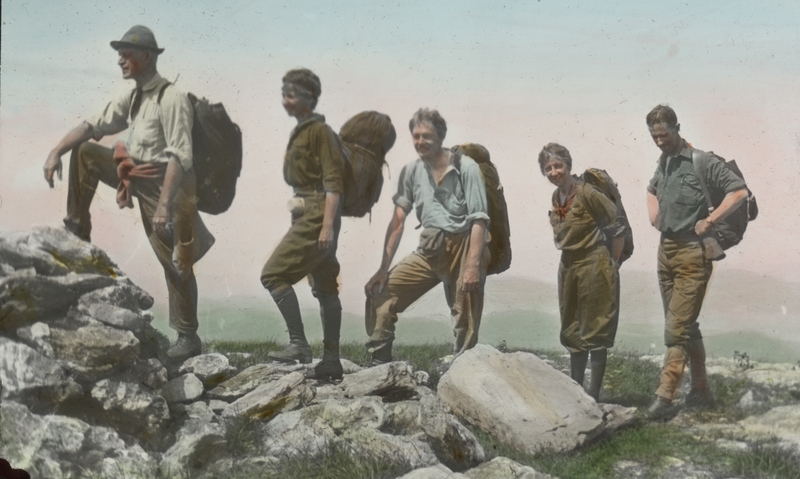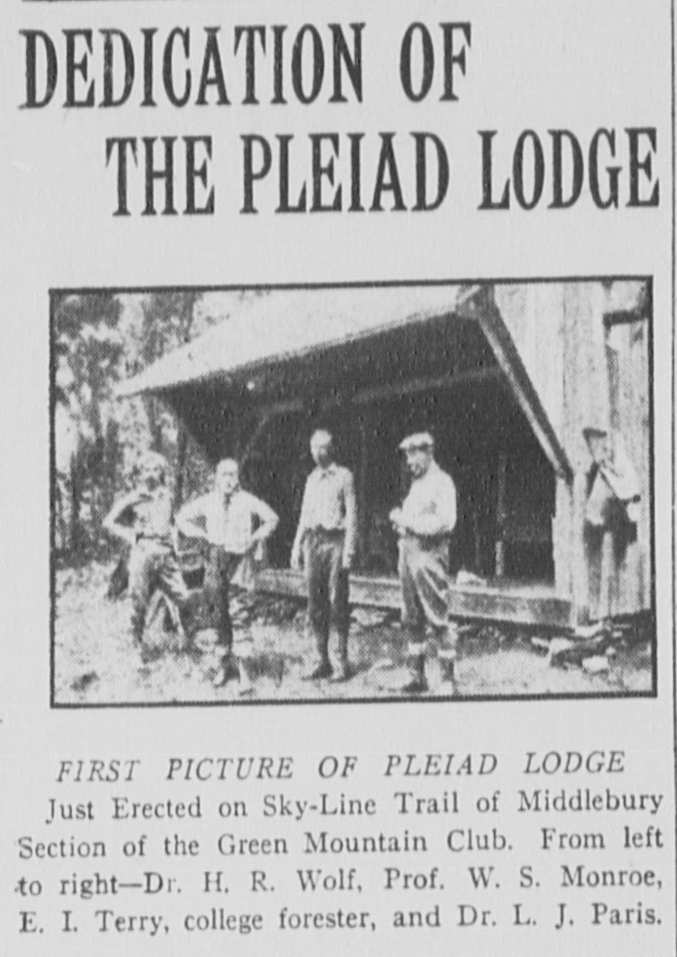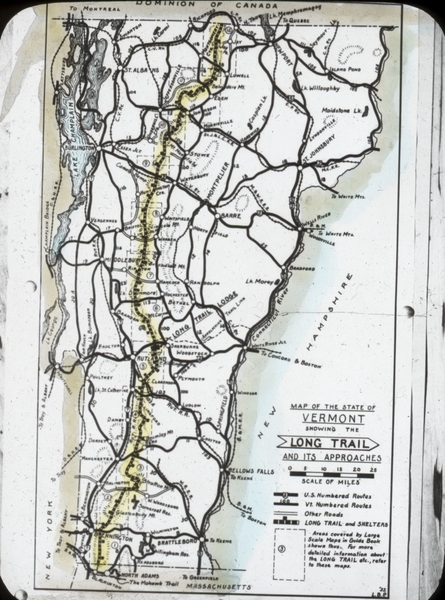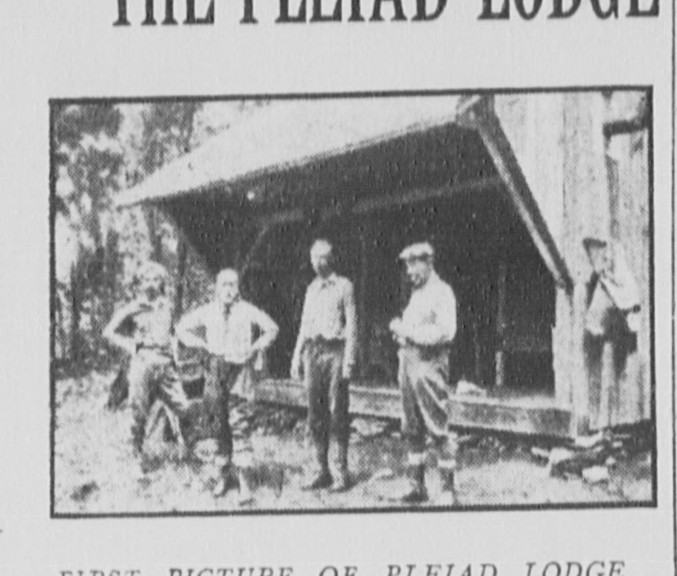
“The value of the free publicity that the Long Trail brings to Vermont, cannot be told. Leading magazines and great city newspapers have told of the glories of sun rises and sun sets seen from these mountain tops.” -News and Citizen, July 21, 1922
At the height of a new focus on nature, the outdoors, camping, hiking, and physical health in Progressive Era America, James P. Taylor (1872-1949), an associate principal of the Vermont Academy at the time, had a vision of creating a trail along the Green Mountains in Vermont to, as one newspaper put it, “awaken the people of Vermont to the neglected beauties of their mountains.” He created the Green Mountain Club in 1910 with the specific intent of designing a trail that would eventually stretch across the state and “make the Vermont mountains play a larger part in the life of the people.” Chronicling America’s historic newspaper pages illustrate the progress of the construction of the oldest long-distance trail in the United States from its very inception through 1922.
Taylor, in a speech at a forestry conference in 1914, outlined his goals for the Long Trail:
“Whether the pedestrian follows a sky line trail perpetually or for variety seeks at times the woodland roads among the foothills, he is ever at home, for this is his kind of a world. We must make it completely his own by elaborating trails and shelters throughout the whole region, so he will feel himself perfectly welcome everywhere.” –The Bennington Evening Banner, July 20, 1914

The Green Mountain Club tackled the monumental task of creating the trail in a systematic manner, as the Bennington Evening Banner explained in 1915:
“The members are grouped in sections or chapters, each of which has in charge a special region with its problems of of making trails, erecting shelters, and extending fraternal hospitality to the increasing number of mountain lovers who are discovering the Green Mountains.”
Trail-blazing and lodge construction was a slow and time-consuming process during mainly Vermont’s humid and hot summers:
“The difficulties of cutting a footpath through this vegetation were many and great. The greatest obstacle was the slash or cut timber that had been left to rot. This and the underbrush made the building of the trail and a slow and painstaking process…the average distance covered by the foresters in a day was one and a half miles.” –The Bennington Evening Banner, July 25, 1913.


By 1922, 225 miles of the trail were completed. In this year, three girls and one boy were reportedly the first to complete the entire trail built thus far (then stretching from Bennington to Johnson) in seventeen days of continuous walking. The Bennington Evening Banner covered the story in great detail–one participant gave a thorough account of their travels, right down to their food stocks: “As for food: we avoided canned goods, which we found those we met carrying in abundance. Our supply consisted chiefly of bread, butter, eggs, shredded wheat, raisins, crackers, rice and sugar, and then; various things, such as cookies and candy…”

Eight years later, in 1930, the trail was finished, reaching across the length of the state from the Massachusetts border to the Canadian border (270 miles), and, as Taylor predicted in 1914, it did in fact “become a most significant and characteristic state institution in Vermont.”
Have you done any hiking and/or camping this summer along the Long Trail? Or have you ever hiked the entire distance?
-K. Norwood, digital support specialist, VTDNP
Additional articles of interest on Chronicling America:
- “Mansfield to Camel’s Hump,” Burlington weekly free press. (Burlington, Vt.), 03 Aug. 1911. Chronicling America: Historic American Newspapers. Lib. of Congress. <https://chroniclingamerica.loc.gov/lccn/sn86072143/1911-08-03/ed-1/seq-7/>
- “The Long Trail,” The Bennington evening banner. (Bennington, Vt.), 15 Sept. 1913. Chronicling America: Historic American Newspapers. Lib. of Congress. <https://chroniclingamerica.loc.gov/lccn/sn95066012/1913-09-15/ed-1/seq-2/>
- “Green Mountain Trail Coming This Way,” The Bennington evening banner. (Bennington, Vt.), 15 Jan. 1914. Chronicling America: Historic American Newspapers. Lib. of Congress. <https://chroniclingamerica.loc.gov/lccn/sn95066012/1914-01-15/ed-1/seq-1/>
- “A Pedestrian’s Paradise: James P. Taylor Speaks on New England Trails,” The Bennington evening banner. (Bennington, Vt.), 30 July 1914. Chronicling America: Historic American Newspapers. Lib. of Congress. <https://chroniclingamerica.loc.gov/lccn/sn95066012/1914-07-30/ed-1/seq-5/>
- “Joys of the Skyline Tramp,” Burlington weekly free press. (Burlington, Vt.), 30 Dec. 1915. Chronicling America: Historic American Newspapers. Lib. of Congress. <https://chroniclingamerica.loc.gov/lccn/sn86072143/1915-12-30/ed-1/seq-16/>
- “Green Mountain Club Annual Winter Outing,” The Bennington evening banner. (Bennington, Vt.), 30 Dec. 1920. Chronicling America: Historic American Newspapers. Lib. of Congress. <https://chroniclingamerica.loc.gov/lccn/sn95066012/1920-12-30/ed-1/seq-5/>
- “Long Trail Day of Green Mountain Club,” The Caledonian-record. (St. Johnsbury, Vt.), 26 May 1922. Chronicling America: Historic American Newspapers. Lib. of Congress. <https://chroniclingamerica.loc.gov/lccn/sn90005351/1922-05-26/ed-1/seq-4/>
- “The Long Trail…Should be extended,” News and citizen. (Morrisville, Vt. ;), 21 June 1922. Chronicling America: Historic American Newspapers. Lib. of Congress. <https://chroniclingamerica.loc.gov/lccn/sn97067613/1922-06-21/ed-1/seq-6/>
For more:
Visit the Green Mountain Club’s website–still dedicated to the maintenance and protection of the Long Trail since 1910.
For more articles on Chronicling America, try searching the keywords of James P. Taylor, Green Mountains, Long Trail, hiking, camping, trail, footpath, mountain, Green Mountain Club, and limiting your search to Vermont between the years of 1900-1922.
For more images of the Long Trail in its early years, see the UVM Center for Digital Initiatives’s Long Trail image collection.


